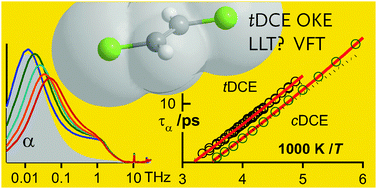The evidence that a molecular liquid in its thermodynamically-stable state can undergo a liquid–liquid transition (LLT) is still uncertain. Therefore, trans-1,2-dichloroethene is of interest due to reports of a LLT above the melting point [S. Kawanishi, T. Sasuga and M. Takehisa, J. Phys. Soc. Jpn., 1982, 51, 1579–1583; S. Rzoska, J. Ziolo, A. Drozd-Rzoska, J. L. Tamarit and N. Veglio, J. Phys.: Condens. Matter, 2008, 20, 244124; K. Merkel, A. Kocot, R. Wrzalik and J. Ziolo, J. Chem. Phys., 2008, 129, 074503–074508]. Ultrafast optical Kerr-effect (OKE) spectroscopy enables accurate measurement of the low-frequency modes arising from interactions in liquids and therefore should be sensitive to the change in liquid structure inherent in such a transition. In the OKE data presented here, no sharp transitions are discernible, nor are there any in calorimetry data. However, the same data do reveal that neither trans- nor cis-1,2-dichloroethene is a simple liquid: in each case, a non-Arrhenius temperature dependence (with a Debye lineshape) is observed for the α relaxation. This dependence can be fitted by the Vogel–Fulcher–Tammann (VFT) law over the measurable temperature range suggesting that at low temperature, cooperative relaxation, due to the formation of clusters or structure, is present. Accurate analysis of the OKE spectrum in the terahertz region is generally limited by approximations inherent in the models. Here the diffusional modes are convoluted with librational modes to give a more physically meaningful approximation to the inertial response.


 Please wait while we load your content...
Please wait while we load your content...